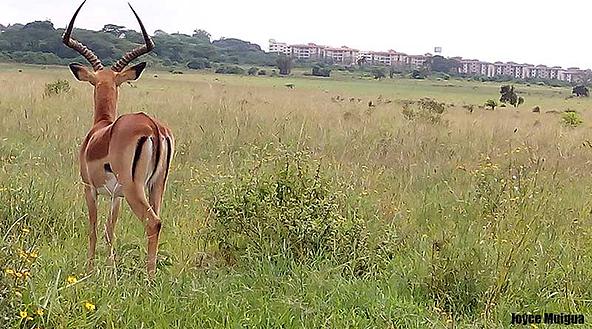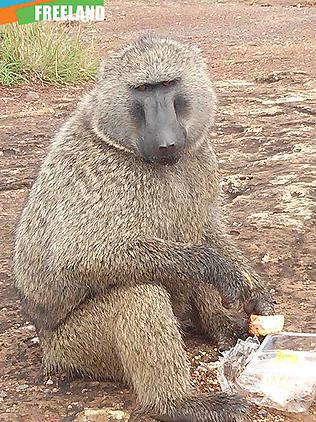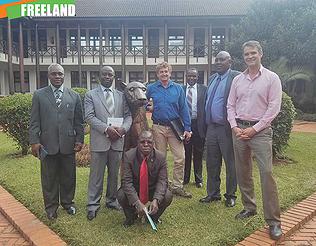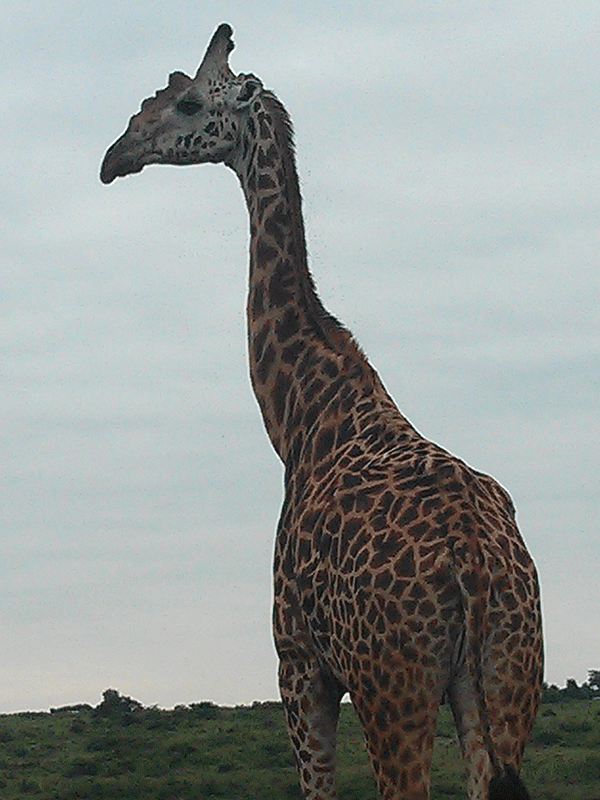
As I watched that naughty, furry, fanged baboon leap into the back seat of our car –pushing aside and scaring the hell out my friend, Tony–, I thought to myself: there’s no big city in the world quite like Nairobi, Kenya.
Most developing world capitals are fast becoming concrete urban jungles, but Nairobi still has real jungle. Much of the city is gushing with green natural beauty, hosting a balance of 3.5 million people and an astounding array of wild animals and plants. Traffic is terrible because the roads are narrow. And when trucks are not over-turning they are bellowing clouds of diesel exhaust. But the city’s voluptuous flora really complements the polite, easy-going people –many of whom are walking home along the roads–, to soothe one’s soul from a bad day at the office. Green Nairobi feels grounding. My high school biology teacher, Tom, once told me “people are instinctively drawn to green because it subconsciously registers as water, which we are hard wired to seek.” The large trees and plants here attract critters too. Eagles and storks hover above lush, personal gardens. The occasional wild pig can be spotted romping near pedestrians. But it gets better. You can be meeting lawyers in a busy downtown office complex in the morning, then drive six miles out and be looking at rhinos, zebras and giraffes in the afternoon, not in a zoo, but in their own natural environment.

Living so close to nature reminds one that we are all animals with similar basic needs for food, love and security. Basic security means shelter, as well as protection against those wanting to steal your food, love or shelter. So it was ironic –and hilarious– that the baboon knocked aside ex-Special Forces army officer Tony, and successfully snatched our food. Then there the big guy sat, peeling off the plastic cover and eating an entire cake in front of us all, refusing to share even a crumb with the other baboons that arrived to offer perimeter defense against the growing paparazzi. This baboon was a lone operator, and reminded me that animals too are capable of greed and corruption, or he was just having a bad day.
Like the wild dogs and vultures we saw earlier that were hunting in packs, we have come to Africa to form a hunting team. But we are not looking for wild animals. We are tracking down those who are killing them. In the past month alone, 11 tons of tusks, the remains of some 1,000 poached elephants, have been seized by Thai and Singaporean authorities. Rhino horns and big cat teeth were mixed in the same hidden containers. All were coming from Africa, some smuggled out of Congo, the rest out of Mombasa, 440 kilometers southeast of here. No arrests of the masterminds have been made yet. Based on our experience, we worry there never will be unless we stick our noses in. So we have come from Asia, invited by like-minded Africa-based partners, to team up.
Rumors still circulate that drug traffickers and terrorists may be behind the multi-million dollar shipments of death, which were destined for Laos and Vietnam, presumably for onward sale to China, the world’s largest market for elephant ivory. Whatever the truth is, green and easy-going Kenya and the surrounding region have dark sides that may offer clues. Some of the tusks seized in Asia already had confiscation markings on them, suggesting they came from government stocks. Was it someone with access, and if so, in which country? Kenya is often a transit country for wildlife traffickers. Or was it worse? Just before the first seizures, 400 kilometers north of Mombasa, ethnic Somali, Al Shabaab gun-men randomly executed 147 students inside Garissa University, representing a shocking calling card for the Kenya government, which has been sending troops into Somalia since 2011 to fend off these terrorists. Elephant Action League investigators reckon that Al Shabaab derives 40% of its salaries from ivory trafficking.

An elephant tusk carved by top-end sculptors can fetch $300,000 in China, while rhino horn is now selling for over $70,000 a kilo as medicine in Vietnam. That’s a lot of bullets, or a fleet of nice cars for a crook or corrupt official. In any case, this is no country for old men or traditional conservationists. So we have hired people like Tony, a former Australian SAS army officer, to help us find, train, and support Africa’s finest. We have hired former police and wildlife wardens from Kenya and South Africa, as well as former FBI and DEA officers with global experience in fighting organized crime. We have a genius analytical team that scans the horizon for data, then weaves it into intelligence packages to support law enforcement. I call them “Zero-dark-wild”. We are forming a pack. And we are connecting.
Connecting is the key. Our team, Freeland, can’t fight poachers and traffickers on our own. We’re small and we’re an NGO. But those can be strengths too. We move quickly and bring good people together and catalyze action. In this case, it’s about bringing good, brave and smart people together from Africa and Asia to stop this poaching madness. In the last year alone, over 25,000 elephants were slaughtered for their tusks to feed the ivory trade. Rhinos are hurting too. Last year Africa lost around 1,500 rhinos to poachers and there’s only 25,000 left.
There are excellent men and women here in Africa circumventing bureaucracy, corruption and death threats in pursuit of the poachers and kingpins behind this killing. But they need help. They need modern training, money, equipment, and from what I can tell, they need a supportive international spotlight. Not just to help their morale, but also to protect them against crooks and corrupt elements that would otherwise seek revenge. It’s easier to rough someone up in the dark than it is when they’re in the news. We have trained and supported some incredible officers in Asia for the past 15 years who have overcome similar challenges. We will build a cooperative bridge between these African and Asian officers, allowing them to piece together the criminal puzzle and then dismantle it. We will shine a spotlight on their successes. And before the syndicates develop deeper roots or grow new heads, another part of our team will already be working furiously to get inside the consumer’s head to turn that wildlife demand switch off.
While organized crime and corruption are not new to Freeland, Africa represents somewhat new territory. So, unsurprisingly, some members of the wildlife conservation community here are still wary of our arrival, sniffing around us to see if they will fight or join us. They don’t want us getting in their way, and they don’t want us to steal their food or territory. We do need their help on this hunt.
Last year we financed 20 African and Asian investigation teams to gather and share intelligence on poachers and traffickers. It paid off. Investigators from Africa’s “Lusaka Agreement Task Force” and Chinese agents worked hand in hand to sting an ivory trafficking ring made up of African and Chinese criminals in Nairobi. The Chinese even took several of the crooks home and stuck them in jail. Initiated by Freeland, “Operation Cobra” resulted in hundreds of arrests and seizures and has now been adopted by INTERPOL as a permanent project. Some of our African friends remember this success and have invited us to join forces on this mission.
Which is what? Just saving animals?

What instinct motivates people to risk their lives to save elephants, lions, rhinos, tortoises and other creatures? Is it the thrill? Maybe, partly. My favorite anthropologist, Joseph Campbell interpreted the daring action of soldiers who risked their lives on perilous helicopter rescue missions because “by God, it makes you feel alive!” He also explained that a man who pulled a stranger back from falling off a high cliff at the risk of falling himself represented an inner sense of connectedness to one another. If you die, I die.
But animals? Profits from wildlife poaching and trafficking are strengthening crooks and terrorists who in turn threaten people. So protecting animals is also about human security. Moreover, I think we’re connected to animals, biologically and spiritually. Anyone who stares into the eyes of their dog or cat knows what I mean. I got the same feeling watching a giraffe in Nairobi National Park. On a bad day, I can even relate to that selfish baboon, or those hard-working dung beetles pushing those giraffe poop boulders up the hill with impressive perseverance. I also have my own crazy theory: Our souls need a host when our bodies die, and some of those hosts are animals. Perhaps we are instinctively wired to prevent extinction so that our own spirits live on.